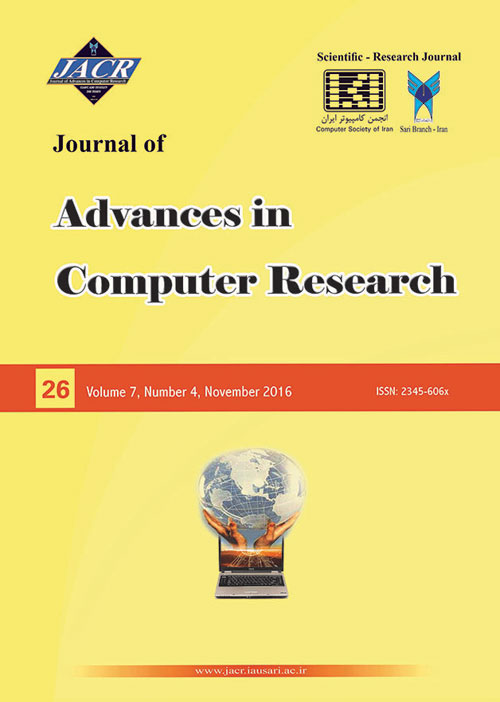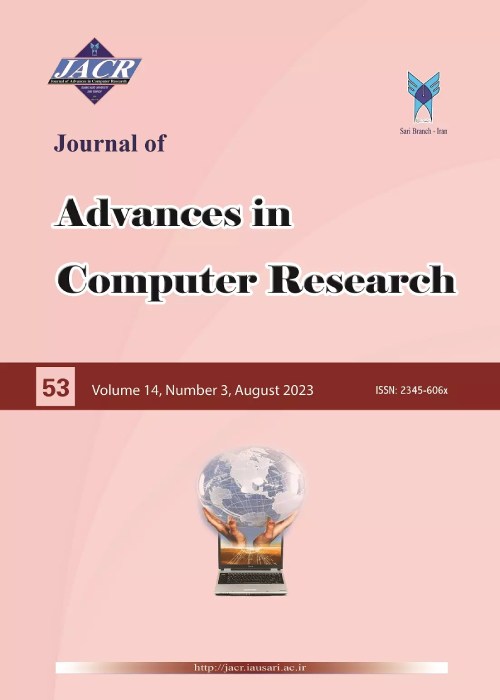فهرست مطالب

Journal of Advances in Computer Research
Volume:7 Issue: 4, Autumn 2016
- 140 صفحه،
- تاریخ انتشار: 1395/07/22
- تعداد عناوین: 10
-
Pages 1-12Nowadays, software cost estimation (SCE) with machine learning techniques are more performance than other traditional techniques which were based on algorithmic techniques. In this paper, we present a new hybrid model of multi-layer perceptron (MLP) artificial neural network (ANN) and ant colony optimization (ACO) algorithm for high accuracy in SCE called Multilayer Perceptron Ant Colony Optimization (MLPACO). Current research uses some of features for increasing accuracy of estimation among of the existing parameters has been considered for effort estimation in software projects, and then these selected features will be filtered by ACO algorithm in order to reach highest accuracy in estimation and optimization of MLP ANN method. The results show that this novel approach with high accuracy for more than 80% cases is better than algorithmic constructive cost model (COCOMO) in the majority cases. Also, the results of proposed algorithm show that mean magnitude of relative error (MMRE) in the proposed algorithm is lower than COCOMO model.Keywords: Software Cost Estimation, Artificial Neural Network, Ant Colony Optimization, Effort, Optimization
-
Pages 13-25RFID system is a wireless technology that can transfer data between tags and readers via radio frequency. In an RFID network, readers are located close to each other to obtain optimal connectivity and sufficient coverage. In such an environment, which is called dense reader environment (DRE).Different types of collisions such as Reader-to-Reader and Reader-to-Tag ones, often lead to serious problems such as decreasing the performance. Accordingly, providing an appropriate method to resolve reader collision appeared to be one of the most important research topics in the field. To solve this problem, different methods have been introduced of which NFRA protocol has higher throughput. In this paper, we use multi-channel technique and sift distribution function on the NFRA protocol to improve RFID system throughput while avoiding increase in reader collision. In addition of supporting mobile reader, the proposed method provides higher throughput compared to other protocols in dense environments.Keywords: RFID System, Dense Reader Environment, Reader to Reader Collision, Reader to Tag Collision, Throughput
-
Pages 27-39The proliferation of Information and Communications Technology (ICT) along with the incremental growth in the use of Cloud services, enterprise network and data center technologies in recent years, have caused unprecedented expansion of computer networks. However, the existing network architecture was not well designed to meet the requirements of today's needs. One of the most important problems in the existing large networks is the lack of abstracted, uniform and centralized global view of the network state and configuration. The efforts to achieve this goal lead us to construct a novel SDN based system to give network visibility to operators and management applications. In this paper, we have a new look to the importance of the logically centralized control plane, abstraction and network's global view. To prepare this network-wide visibility for the use of applications in management plane, we have designed and implemented a new northbound interface and a key-enable control module called CTRLmod based on SDN in POX platform. To show how the system works, GVpresent is developed to graphically display real-time network topology, state and configuration.Keywords: SDN, Network-Wide View, Network Abstraction, Centralized Control
-
Pages 41-53In this paper by combining caching and replication techniques proposed a hybrid heuristic method based on the greedy algorithm to use the benefit of each other techniques. The algorithm in each interaction compares all the contents and one that made the best benefit value is selected for replication. The hybrid approach tested in a simulation environment and the results show that hybrid algorithm again stand-alone replication, reduced the average response time by 42% and compared to the pure caching, saving up 23% user requests time.Keywords: Content Delivery Network (CDN), Hybrid Algorithm, Replica Placement
-
Pages 55-66Discrimination between iron deficiency (IDA) anemia and β-thalassemia trait (β-TT) is a time consuming and costly problem. Because, they have approximate similar effects on routine blood test indices, in some cases, the complementary tests, which are expensive and time consuming, would be needed for differentiate the anemia. Complete blood count (CBC) is a fast, inexpensive, and accessible medical test that is used as a primary test for diagnosis anemia. However, when the CBC indices cannot exactly state the subject, more advanced tests such as electrophoresis of hemoglobin must be performed. In this study, the CBC indices have been considered as the inputs of classifier and the chosen architecture is pattern-based input selection artificial neural network (PBIS-ANN). For evaluation the proposed method, traditional methods, which are still using for the problem such as Mentzer Index (MI), and several automated anemia diagnostic systems such as artificial neural networks (ANN), adaptive neuro-fuzzy inference system (ANFIS) and multi-layer perceptron (MLP) have been compared with the proposed method. The results indicate that the proposed method significantly outperforms the mentioned methods.Keywords: Iron Deficiency Anemia, β, Thalassemia Trait, Artificial Neural Network, Complete Blood Count, Hemoglobin
-
Pages 67-78In this manuscript we suggest a fast adaptive distributed method for maximum likelihood approximation (MLA) in multiple view object localization problem. For this purpose, we use "up to scale" property of projective geometry and by defining coefficients for convergence criterion, we increase the convergence speed of the consensus algorithm. We try to present a mathematical model for the problem. We use two types of error function. The proposed method uses maximum likelihood for obtaining its best parameters. Our approach utilizes "up to scale" property in projective geometry to reach the consensus quickly. The difference between node's values and meanwhile consensus values are evaluated by two error functions. To estimate consensus value in the second error function, we used local weighted average of each node. At the last of the paper, we prove our claims by experimental results.Keywords: Maximum Likelihood Approximation, Data Fusion, Consensus Algorithm, Homography
-
Pages 79-93Data grids support access to widely distributed storage for large numbers of users accessing potentially many files. To enhance access time, replication at nearby sites may be used. Data replication, a technique much investigated bydata grid researchers in past years creates multiple replicas offile and places them in conventional locations to shorten fileaccess times. One of the problems in data replication iscreation of replicas, replica placement and replica selection. Dynamic creation of replicas in an appropriate site by datareplication strategy can increase the systems performance.In this paper, we propose a data replication algorithm, called the Utility-base Data Replication (UDR) algorithm that improves file access time. Each grid site has its own capabilities and characteristics; therefore, choosing one specific site from many sites that have the needed data is a key and significant decision. The replica selection problem has been studied by many researchers who only considered response time as a criterion for the selection process. Therefore, in this study, we addressed the problem of how to select the best replica for the user's jobs. Our approach is simulated using a data grid simulator, OptorSim, developed by European Data Grid projects. Comparing to the previous work the experimentation shows the improvement in the overall performance.Keywords: Data Grid, Data Replication, Simulation, Replica Selection
-
Pages 95-107Usually in the form of parallel processing with parallel multi-processor systems are designed .For this reason irregular flow may occur with packages. When youre tired and it all comes out in his NP (Network Processors) system, Reset depending on network performance is negatively affected and we delayed To do this, The design of processors working in parallel packet transmission by avoiding any packet reordering occur, If reordering, this time delay is minimal. Several algorithms have been proposed in recent years. In this paper, we will describe some of the fundamental concepts involved in NP architecture and algorithms packet reordering in recent years, which causes delays are minimized packet reordering, the evaluation will be compared.Keywords: Network Processors, Packet Reordering, Parallel Architectures
-
Pages 109-124Every woman is at risk of ovarian cancer; about 90 percent of women who develop ovarian cancer are above 40 years of age, with the high number of ovarian cancers occurring at the age of 60 years and above. Early and correct diagnosis of ovarian cancer can allow proper treatment and as a result reduce the mortality rate. In this paper, we proposed a hybrid of Synthetic Minority Over-Sampling Technique (SMOTE) and Artificial Neural Network (ANN) to diagnose ovarian cancer from public available ovarian dataset. The dataset were firstly preprocessed using SMOTE before employing Neural Network for classification. This study shows that performance of Neural networks in the cancer classification is improved by employing SMOTE preprocessing algorithm to reduce the effect of data imbalance in the dataset. To justify the performance of the proposed approach, we compared our results with the standard neural network algorithms. The performance measurement evaluated was based on the accuracy, F-measure, Recall, ROC Area Margin Curve and Precision. The results showed that SMOTE MLP (with above 96% accuracy) performed better than SMOTE RBF and standard RBF and MLP.Keywords: Artificial Neural Network, RBF, SMOTE, MLP, Data Imbalance, Ovarian Cancer
-
Pages 125-140Advanced data mining techniques can be used in universities classification, discovering specific patterns in the determination of successful students, design of a plan or a teaching method and finding critical points of financial management. In this article, we proposed a method to predict the rate of student enrollment in coming years. The data for this research were from data sets of volunteers postgraduate Islamic Azad university entrance exam. At first stage, we built 15 different neural networks. In order to increase the accuracy, we employed the collective bagging and boosting models. Finally, the four models, neural networks, decision trees, Bayes simple and logistic regression, were applied on the dataset and evaluate by three criteria included, accuracy, Matthews correlation and ROC curve. The findings indicated that to predict Students who were accepted would enroll; the bagging method is the most accurate one.Keywords: Bagging Model, Boosting, Model, Decision tree, Bayesian Simple, Kappa Precision, Mathews Correlation, T, Test Curve


